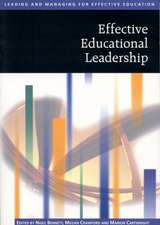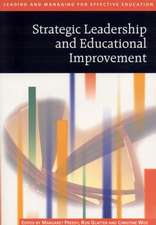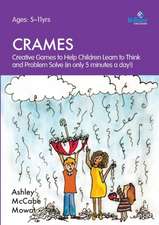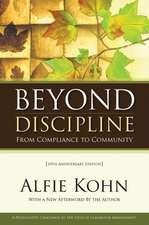How to Use Value-Added Analysis to Improve Student Learning: A Field Guide for School and District Leaders
Autor Kate Kennedy, Mary Peters, James M. Thomasen Limba Engleză Paperback – 18 ian 2012
Preț: 282.62 lei
Nou
Puncte Express: 424
Preț estimativ în valută:
54.10€ • 58.78$ • 45.47£
54.10€ • 58.78$ • 45.47£
Carte tipărită la comandă
Livrare economică 21 aprilie-05 mai
Preluare comenzi: 021 569.72.76
Specificații
ISBN-13: 9781412996334
ISBN-10: 1412996333
Pagini: 200
Dimensiuni: 178 x 254 x 13 mm
Greutate: 0.41 kg
Ediția:1
Editura: SAGE Publications
Colecția Corwin
Locul publicării:Thousand Oaks, United States
ISBN-10: 1412996333
Pagini: 200
Dimensiuni: 178 x 254 x 13 mm
Greutate: 0.41 kg
Ediția:1
Editura: SAGE Publications
Colecția Corwin
Locul publicării:Thousand Oaks, United States
Recenzii
“This book offers a practical, engaging introduction to value-added assessment — it should be read by educators at all levels. The authors demystify a complex topic, and give educators the tools they need to use value-added data to help students learn.”
"Value-Added Assessment is an extraordinarily important breakthrough in education research that provides a direct empirical measure of instructional effectiveness at the classroom level. This book could not be more timely, given the sea change now underway in how teachers and administrators are being evaluated and compensated."
“A welcome, plain-spoken and eminently practical guide to making the most of value-added analysis to strengthen data-driven decision making and boost achievement in our schools.”
"As districts across the country rapidly ramp up for using value-added performance measures in teacher evaluations, this book will provide invaluable information on making that data positive and productive, rather than frightening and antagonizing.”
"Value-Added Assessment is an extraordinarily important breakthrough in education research that provides a direct empirical measure of instructional effectiveness at the classroom level. This book could not be more timely, given the sea change now underway in how teachers and administrators are being evaluated and compensated."
“A welcome, plain-spoken and eminently practical guide to making the most of value-added analysis to strengthen data-driven decision making and boost achievement in our schools.”
"As districts across the country rapidly ramp up for using value-added performance measures in teacher evaluations, this book will provide invaluable information on making that data positive and productive, rather than frightening and antagonizing.”
Cuprins
List of Figures
Foreword
Preface
Acknowledgments
About the Authors
1. Step I: What Is Value-Added Analysis?
2. Step I: Jump into Value-Added Analysis
3. Step I: The Framework for Systemic Improvement
4. Step II: Assess District-Level Value-Added Reports to Determine Strengths and Challenges
5. Step II: Assess Building-Level Value-Added Reports to Determine Strengths and Challenges
6. Step II: Assess Teacher-Level Value-Added Reports to Determine Strengths and Challenges
7. Steps III and IV: Identify Root Causes and Produce an Improvement Plan
8. Step V: Take Action, Monitor, and Adjust
Afterword
Glossary
References
Index
Foreword
Preface
Acknowledgments
About the Authors
1. Step I: What Is Value-Added Analysis?
2. Step I: Jump into Value-Added Analysis
3. Step I: The Framework for Systemic Improvement
4. Step II: Assess District-Level Value-Added Reports to Determine Strengths and Challenges
5. Step II: Assess Building-Level Value-Added Reports to Determine Strengths and Challenges
6. Step II: Assess Teacher-Level Value-Added Reports to Determine Strengths and Challenges
7. Steps III and IV: Identify Root Causes and Produce an Improvement Plan
8. Step V: Take Action, Monitor, and Adjust
Afterword
Glossary
References
Index
Notă biografică
Descriere
This step-by-step guide shows how to transform schools with value-added analysis, the most robust, statistically significant method for measuring student learning over time. The authors feature a five-step continuous improvement model that shows how to use value-added data both in the classroom and schoolwide to raise student achievement.











